
Jump to:
Many Japanese adults claim to be hit by a wave of nostalgia when passing by Dagashiya, stores selling Dagashi (Japanese penny snacks). Priced deliberately low to enable children to buy a wide variety of snacks with loose change, these stores are often “mom-and-pop” stores owned by the same family for generations and have an important place in Japanese food culture, especially in the area of Japanese snacks.
With display boxes placed deliberately low to accommodate the height of their main clientele, they are not only a safe place where children can go alone but also provide a useful opportunity to initiate children in the process of shopping and handling money.
Because of their retro feel, dagashi bars are also becoming popular in the Tokyo area, attracting the older generation, and some dagashi “bars” now stay open until 3 am.
In this article, we shall take a look at the history of Dagashi, consider different types of Dagashi, discuss some famous Dagashiya, and look at the difference between Dagashi and Wagashi.
History Of Dagashi
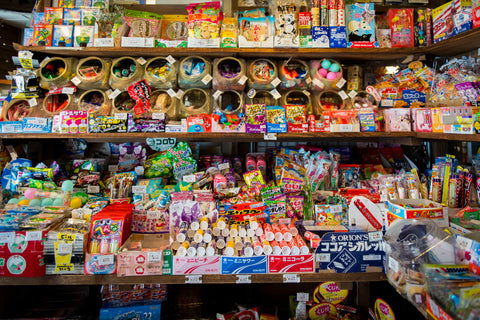
Dagashi were first created in the Edo period (1603-1868) and were made from low-cost ingredients such as starch and corn, thus making them accessible to the commoners in Japan, acting as a contrast to the higher quality Jogashi, which were made with white sugar, an expensive ingredient that put these sweet delicacies out of the reach of many people during those times.
After the Second World War, sugar became cheaper and Dagashi started to embrace sweeter snacks in its repertoire. Dagashi reached its peak of popularity during the period of the Showa emperor from the 1950s to the 1980s, and Dagashiya became a popular hangout for children after school.
However, Dagashiya suffered during the bubble economy in Japan from 1986 to 1991, when the increased spending power available to children led them to branch out into higher-priced snacks in convenience stores and the like. Despite this wane in their popularity, a number of Dagashiya have survived (there are still approximately 50 in Tokyo) and are still a popular haunt of both children and adults.
Types Of Dagashi – Classic Vs Modern Dagashi
As there are approximately 5000 types of Dagashi, it is not possible to provide an exhaustive list here but let us take a look at some of the major categories.
The first major way of categorizing Dagashi is into classic and modern Dagashi. The classic variety are the snacks that have existed since the earliest days of the Dagashi and those based on dried base ingredients that would guarantee a longer shelf life without the need for refrigeration, which has only become readily available in more recent times. These dried ingredients include things like seafood, fruit, and vegetables. They also rely a lot on starch or rice-based sweetening agents. Modern Dagashi were introduced after sugar and particularly chocolate became more affordable and shops had greater access to refrigeration.
Let’s start by looking at classic Dagashi.
Umaibo
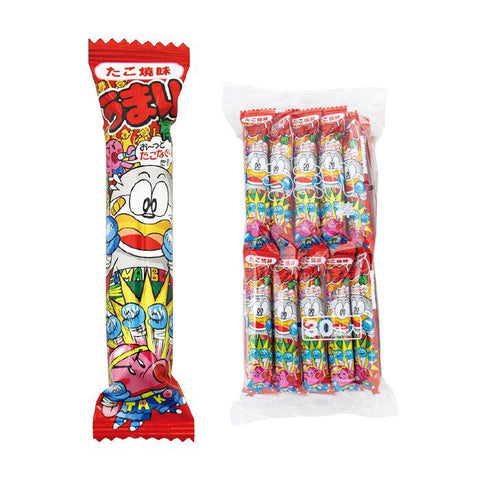
Classic Dagashi include both savory and sweet items. On the savory side, Umaibo is a puffed corn snack that comes in a variety of flavors, including cheese, takoyaki (baked octopus), mentaiko (spicy cod roe), corn potage, and teriyaki flavors. Even after its manufacturer found itself unable to fight off inflationary pressures and gave the popular snack its first price rice in decades, it remains a very affordable 12 yen in price.
Sukonbu
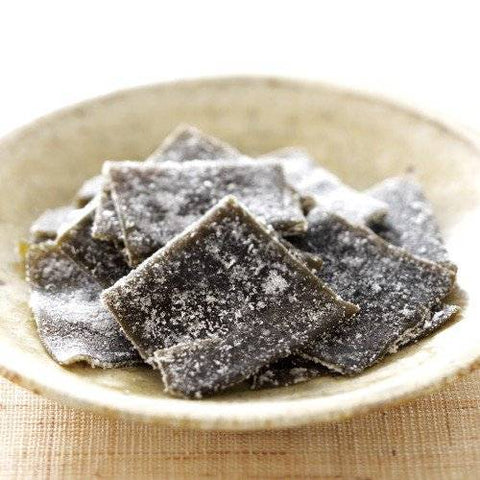
Another classic savory type of Dagashi is Sukonbu, a name made up of the two words Su (meaning vinegar), and Konbu (kelp). As its name suggests, it consists of strips of kelp flavored with vinegar. The vinegar has the twin functions of acting as a preservative and stimulating the appetite.
Konpeito
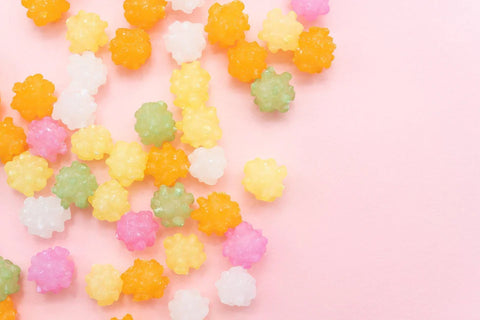
But not all classic Dagashi are savory. Konpeito is a colorful, star-shaped hard candy, which is usually unflavored. The candy was said to have been introduced by Portuguese missionaries in the 16th Century, with its name coming from the borrowed word “konfeito”, referring to confectionery (You can check out this article for more info, and try it here).
Karinto

Karinto is another sweet type of classic Dagashi. This deep-fried snack is made of flour, yeast, brown sugar, and baking soda. The dough is formed into a stick shape and fried in vegetable oil. This snack is so popular in Japan that there are even specialist stores selling only Karinto.
Meiji Chocolate and Candy

When it comes to sweet modern Dagashi, sugar, and fruit play a starring role. Chocolate was prohibitively expensive in the early days of Dagashi, but chocolate now has a firm place in the Dagashi repertoire. This Meiji Apollo Chocolate is now a firm favorite in Dagashiya stores, as is this butter scotch candy from the same company.
Ramune
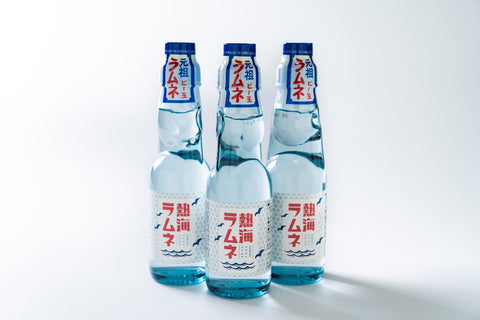
Another sweet type of modern Dagashi is ramune. Ramune is a popular soda drink in Japan, served in characteristic blue bottles, and the flavor has been adapted into a hard blue candy snack of the same name.
Baby Star Ramen

On the savory side of modern Dagashi, baby star ramen is incredibly popular in Japan. These are crushed and dried noodles seasoned with flavors found in ramen dishes, such as chicken stock and soy sauce.
Big Katsu
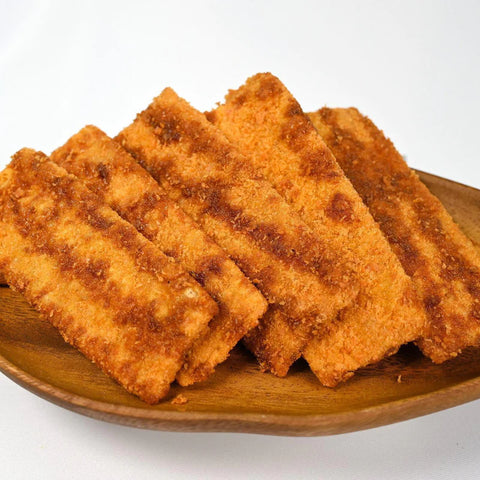
“Big Katsu” from the company Suguru is a bite-sized snack that is meant to resemble Tonkatsu, the main dish of pork fillets fried in breadcrumbs. You can try this highly popular snack here. And if you have a craving for some squid, try this spicy batter-fried squid snack from Natori.
Naturally, this section only scratches the surface of the many types of Dagashi available, and exploring the shops and finding things to try is definitely part of the fun. If you need a few pointers to get yourself started, however, this article has plenty of suggestions for those of you with a sweet tooth.
Some Famous Dagashiya

The official largest Dagashiya in Japan can be found in Setouchi City in Okayama Prefecture. Called, fittingly “Nihon-ichi no Dagashi Uriba” (Japan’s biggest dagashi stand), it is located in the middle of a rice paddy field, and is said to be a tourist attraction that attracts many visitors from all over Japan and overseas.
From the outside, it has the appearance of a vast factory or warehouse, but inside it is one of the largest candy stores in Japan, with 6,000 different products displayed on its 2,500 m2 sales floor. The store is designed to attract adults as well as children, and whereas the products are arranged in a low position that makes it easy for children to shop, it also has a bulk sales section and a section for adult purchases.
Nihon-ichi no Dagashi Uriba may be the largest Dagashiya in Japan, but it is not the oldest. To visit the oldest store in Japan, you will need to go to the grounds of Zoshigaya Kishimojindo Temple in Toshima Ward, Tokyo. The store, which somehow managed to avoid burning down in the air raids on Tokyo during the Second World War was originally a candy shop for the Maeda family of the Kaga Domain and is now in its 13th generation.
Is Dagashi The Same As Wagashi?
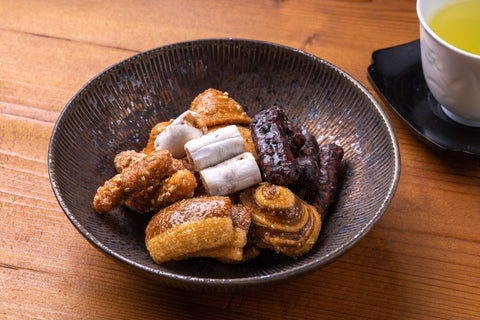
Although their names sound may sound similar, Dagashi and Wagashi refer to very different types of Japanese snacks. In fact, even though the second character in Wagashi means snack, they tend to be eaten on more formal occasions and are quite far removed from what we normally think of as snacks.
As mentioned before, the target purchasing group of Dagashi is mainly children (or adults reminiscing on what it was like when they were children). The design of the shops is based around providing easy access to the merchandise for the height-challenged, the prices are cheap enough for kids to buy a wide variety of items with their pocket change, and the packaging tends to be cute or fun for children.
Historically speaking as well, Dagashi were invented to provide snacks for commoners unable to afford the delicate, sugar-based treats of Wagashi.
Wagashi are significantly more expensive than Dagashi, and whereas the presentation of Dagashi aims at being fun, the art of Wagashi is to present confectionery in an aesthetically pleasing way, with certain Wagashi sometimes reflecting the changing of the seasons. The flavors are also more subtle and designed to be enjoyed with green tea. Whereas children will eat Wagashi as well, this tends to be in more formal situations or when bought for them by their parents, as it is unlikely that most children’s pocket money would stretch to purchasing Wagashi. You can learn more about Wagashi here.
Dagashi - An Endangered But Important Part Of Japanese Food Culture

As a result of such factors as the declining birth, and the fact that low-priced snacks are also sold at low prices in convenience stores, Dagashiya are disappearing from Japan one after the other and can be said to be a culturally endangered species. Many Dagashiya are mom-and-pop stores that are desperately trying to survive despite dwindling profit margins.
Dagashiya, however, still have an important role in Japanese food culture. For adults, a Dagashiya is like a time machine that brings back happy memories of childhood. They also provide a safe place for children where they can learn practical shopping skills. For this reason, among others, it is hoped that they can ride out the current economic challenges.
Do you have a favorite type of Dagashi? Let us know in the comments.


0 comments